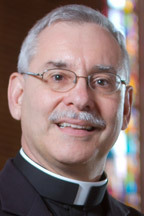
Bishop Anthony B. Taylor delivered this homily March 8.
Today’s Gospel is quite familiar to us: the cleansing of the Temple, except that John’s version which we have today is different from what we find in the other Gospels.
In Matthew, Mark and Luke, this courageous action took place near the end of Jesus’ public ministry and, as far as his adversaries were concerned, was the last straw. Mark says, “The chief priests and scribes heard of this and began to look for a way to destroy him” and Matthew and Luke say pretty much the same thing — notice there was no mention of the Pharisees.
In John, however, the cleansing of the Temple took place at the beginning of Jesus’ ministry, right after the wedding feast of Cana, and Jesus’ adversaries are described simply as “the Jews,” which John uses as a kind of shorthand to refer to the chief priests whose identity is spelled out in the other Gospels. This is, of course, an unfortunately broad usage of the term “Jews” because all of Jesus’ supporters were also Jews, many of whom, today’s Gospel says, “began to believe in his name when they saw the signs he was doing.” We have to keep this in mind whenever we read John’s Gospel because misreading his account has too often led simple believers to blame all Jews for Jesus’ death when in fact only a relatively small number of people were involved in it then (and none today!) and it was in fact the Romans — gentiles (our ancestors, so to speak) — who actually killed Jesus.
Notice also that while John places the cleansing of the Temple at the beginning of Jesus’ ministry, he does so with a view to his future passion and death, such that when Jesus says, “Destroy this temple and in three days I will raise it up,” he’s referring to the temple of his body. The material building in which up to now animals have been sold and sacrificed on an altar of stone will soon give way to the spiritual temple of Jesus’ body, the true Lamb of God sold for 30 silver pieces and sacrificed on the altar of the cross.
The second thing to notice is that John’s Gospel talks about “signs,” some of which are miracles like at the wedding feast of Cana, but others are symbolic actions like today’s cleansing of the Temple.
What is significant about each of these signs is their capacity to reveal the identity of Jesus and the glory of God revealed in him. These signs have the purpose of opening their minds to the underlying meaning of the remarkable things they were experiencing, which was crucial because the person who is unwilling to perceive this underlying meaning will be incapable of that personal faith that Jesus seeks in his disciples.
Many people met Jesus but only those who opened their hearts to him truly encountered him, and these signs helped make that possible.
And isn’t it true that you and I encounter Jesus most powerfully through signs even today? That’s what all the sacraments are: “outward signs instituted by Christ to give grace.”
That’s what the Eucharist is: Jesus’ body and blood really present under the signs of bread and wine, and the person unwilling to perceive this reality will be incapable of encountering Jesus through this sacrament — whether at Mass or in adoration, even though he’s really there. And it’s the same with the sacrament of confirmation and indeed, all the sacraments.
So whenever we receive a sacrament, it’s crucial that we open our minds and our hearts to perceive Jesus, who through these signs enters us to cleanse the temple of our soul, to fill us with his presence and to empower us with all the gifts of his Holy Spirit.
Please read our Comments Policy before posting.
Article comments powered by Disqus Don’t sign new abortion petition, Bishop Taylor asks
Don’t sign new abortion petition, Bishop Taylor asks
 Bishop says Hot Springs priest taking leave of absence
Bishop says Hot Springs priest taking leave of absence
 Relationship with God first, vocation is second
Relationship with God first, vocation is second
 Tyler bishop says he will not resign from Texas diocese
Tyler bishop says he will not resign from Texas diocese
 10 things to know about upcoming Synod on Synodality
10 things to know about upcoming Synod on Synodality
 New season of ‘The Chosen’ delayed on streaming sites
New season of ‘The Chosen’ delayed on streaming sites
 Father Keller, oldest diocesan priest, a pro-life champion
Father Keller, oldest diocesan priest, a pro-life champion
 Vatican says abortion, surrogacy attack human dignity
Vatican says abortion, surrogacy attack human dignity
 Iowa basketball superstar supported by Catholic faith
Iowa basketball superstar supported by Catholic faith
 A Catholic You Want to Know: Joan Becker
A Catholic You Want to Know: Joan Becker
 Two gifts after Jesus’ death: Virgin Mary and Eucharist
Two gifts after Jesus’ death: Virgin Mary and Eucharist
 Why we have an altar, and not just a communion table
Why we have an altar, and not just a communion table
 Pope: Wars should be resolved through nonviolence
Pope: Wars should be resolved through nonviolence
 Living relationship with Jesus Christ in the Eucharist
Living relationship with Jesus Christ in the Eucharist
 Crosses: Adversities you could avoid, but are embraced
Crosses: Adversities you could avoid, but are embraced